Whether you like to meal prep, cook each meal, or shake up a smoothie — as a fitness enthusiast, protein is crucial to your diet. Protein helps you build muscle mass and recover from training so you can hit the gym for your next session, ready to keep crushing deadlifts and bench presses.
There are health benefits to a high-protein diet beyond body composition. Eating a balanced diet with enough protein can improve your heart health so you can bang out your HIIT workouts in a flash.
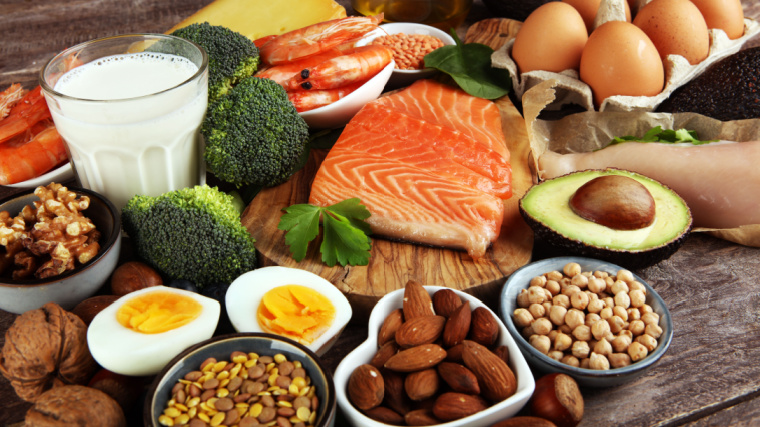
Here, we’ll list the best high-protein foods you’ll want to add to your next meal, along with all their nutritional information. Whether you’re a vegan, vegetarian, or carnivore — we’ve got you covered. We’ll also dive into the benefits of protein and guide you to the amount of protein you need to reach your goals. Let’s get into it.
Editor’s Note: The content on BarBend is meant to be informative in nature, but it should not be taken as medical advice. When starting a new training regimen and/or diet, it is always a good idea to consult with a trusted medical professional. We are not a medical resource. The opinions and articles on this site are not intended for use as diagnosis, prevention, and/or treatment of health problems. They are not substitutes for consulting a qualified medical professional.
- What Is Protein?
- The Best High-Protein Foods
- The Benefits of Protein
- How Much Protein Do You Need?
- Frequently Asked Questions
What Is Protein?
Protein, carbohydrates, and fat are your three macronutrients — the types of foods your body gets energy from. Different foods have a combination of all three. Macronutrients provide energy, influence your health, and make up your daily caloric intake. The quest for the perfect balance is ongoing, but we’ll zero in on the bodybuilder favorite: protein. (1)
Protein is widely known to help build skeletal muscle when combined with a resistance training program. During recovery from exercise, protein aids in repairing and regenerating muscle tissue. That’s why post-workout protein supplements are so popular. (2)
Here’s how it works. Twenty amino acids make up muscle protein; eleven are non-essential, meaning your body naturally produces them. The remaining nine are called essential amino acids. Your body can’t produce them on its own, so you need to get them from eating protein-rich foods. (3)
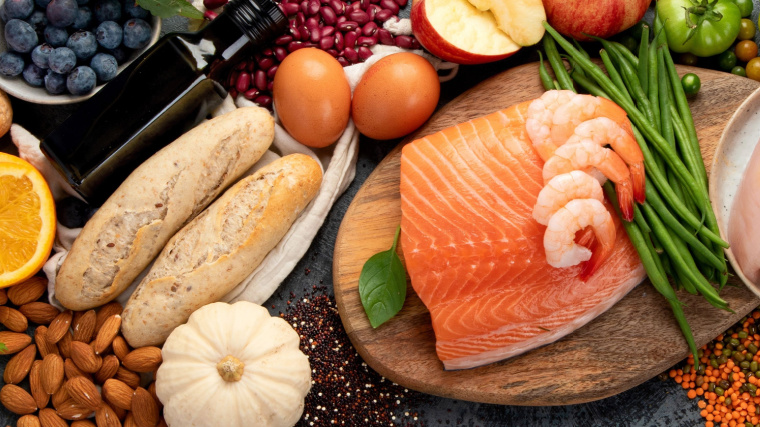
Amino acids are often called the building blocks of protein because they “build” together as a chain. In addition to building and maintaining muscle mass, essential amino acids help prevent metabolic diseases, boost your immune system, and produce hormones and neurotransmitters. (4)
To build muscle, your body needs complete protein sources. A complete protein contains the necessary building blocks: all nine essential amino acids. You can get complete protein from consuming animal-based foods, plant-based foods, and dietary supplements. (4)
Sources of Protein
Nutritionists and dietitians generally recommend getting the bulk of your nutrients through whole food sources and adding on dietary supplements to help you boost your intake when necessary.
You can get the complete protein your body needs by consuming both animal- and plant-based foods and dietary supplements like protein powder.
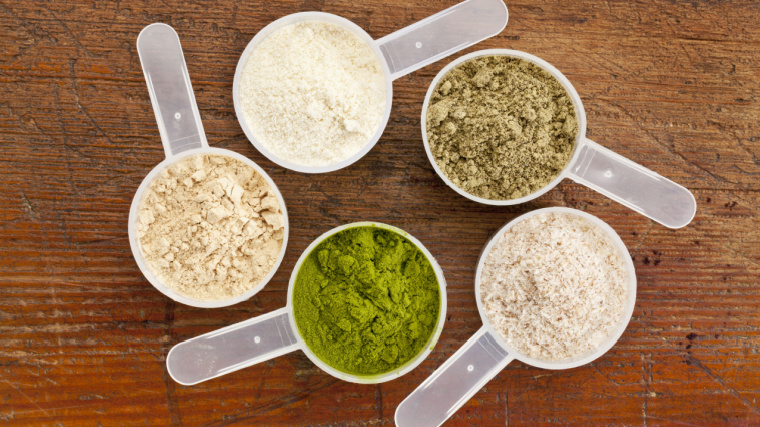
Here’s a bite-sized list before we break each one down further:
- Animal-Based Foods: Poultry, red meat, fish, eggs, and dairy products
- Plant-Based Foods: Tempeh, tofu, soybeans, lentils, and seeds
- Animal-Based Supplements: Whey protein powder and casein protein powder
- Plant-Based Supplements: Soy protein powder and pea protein powder
The Best High-Protein Foods
Let’s get into the meat (or plant-based alternative) of it all. Here are the best foods with the highest protein content so you don’t waste any time in repairing your muscles after all your hard work in the gym.
The nutritional information for each food comes from the FoodData Central page on the United States Department of Agriculture (USDA) website. (5)
- Chicken Breast
- Red Meat
- Salmon
- Dairy Products
- Eggs
- Tempeh and Tofu
- Quinoa
- Edamame
- Lentils
- Beans
- Seeds
- Protein Smoothies
Chicken Breast
We know that chicken breast as a protein option isn’t news to you, but it’s a staple of the fitness enthusiast’s diet for a reason. Chicken breast is an excellent source of lean protein, and you can add spices and seasonings to it for extra flavor.
Chicken breast also contains phosphorous, selenium, and B vitamins — including vitamin B12. These extra nutrients may boost your immune system and energy levels. (6)(7)
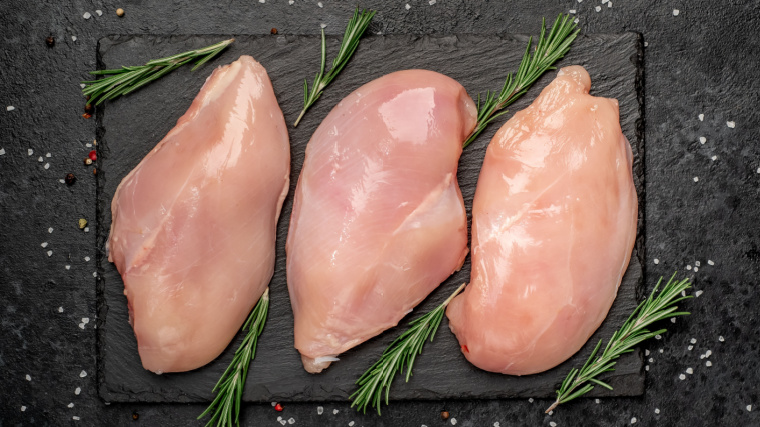
A four-ounce serving of chicken breast has 25.4 grams of protein and 2.96 grams of fat.
Red Meat
Red meat gets a bad rap for being high in cholesterol and saturated fat. If your doctor tells you to avoid it, stick with your medical professional’s advice. If not, when eaten in moderation, red meat is a high source of protein. You can also choose lean cuts of meat to reduce some saturated fat.
A four-ounce serving of lean ground beef yields 24 grams of protein and 5.6 grams of fat.
One three-ounce serving of steak fillet has 25 grams of protein and 7.6 grams of fat.
Salmon
In addition to being a good source of protein, salmon is a highly nutritious food packed with healthy fats — specifically, omega-3 fatty acids. Omega-3 benefits include improving your heart health and boosting your muscle recovery. Salmon is also high in selenium, phosphorus, and B vitamins. (8)(9)
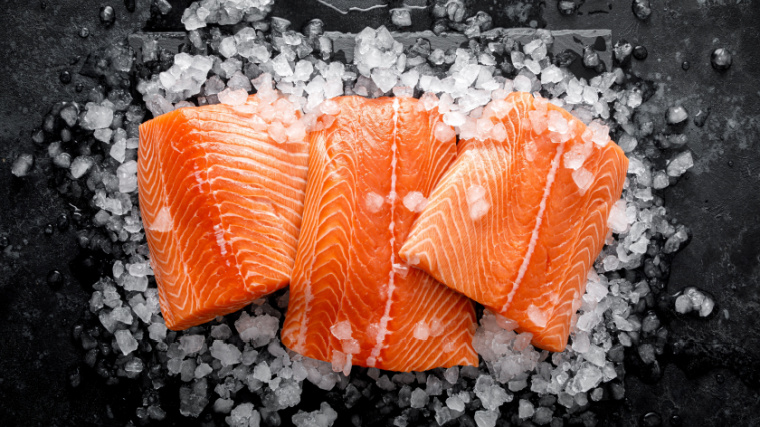
One three-ounce serving of salmon has 17 grams of protein and five grams of fat.
Dairy Products
Dairy products are excellent sources of protein. Greek yogurt, cottage cheese, and other cheeses are protein-packed and contain calcium. You can also get non-dairy alternatives.
A 200-gram serving of low-fat Greek yogurt contains 20 grams of protein, 3.8 grams of fat, and 7.9 grams of carbs.
One 113-gram serving of low-fat cottage cheese yields 14 grams of protein, one gram of fat, and three grams of carbs.
Eggs
Eggs are a quick-cooking and easy source of protein. They’re also a good source of vitamin B12 and other B vitamins.
One large egg packs six grams of protein, five grams of fat, and 0.5 grams of carbs.
Tempeh and Tofu
As we move into plant-based protein options, tempeh and tofu are popular meat alternatives. They are both made from soybeans, making them complete protein sources — they contain all the essential amino acids you need to build muscle.
One three-ounce serving of tempeh packs 15 grams of protein, nine grams of fat, and nine grams of carbs.
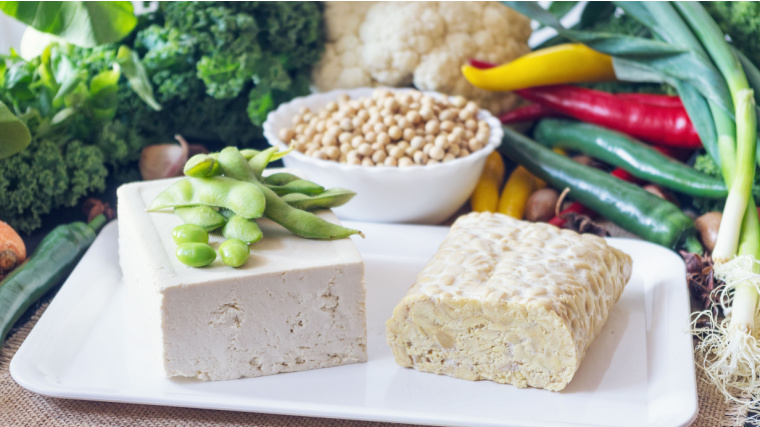
A 3.5-ounce serving of firm tofu contains 17 grams of protein, nine grams of fat, and three grams of carbs.
Quinoa
Quinoa is a whole grain that doubles as a protein option. It’s not super high in protein by volume, but it makes a great addition to a stir-fry with tempeh and veggies. Quinoa also contains other nutrients like folate, fiber, zinc, and antioxidants. Including quinoa in your diet may lower your risk of heart disease. (10)
A one-cup serving of quinoa yields 8.1 grams of protein, 3.5 grams of fat, and 39.4 grams of carbs.
Edamame
Edamame beans are a type of soybean. They’re from the legumes family and are an excellent source of healthy carbs. Edamame also contains folate and vitamin K. They’re high in protein, making them good vegan protein sources for athletes.
A one-cup serving of edamame contains 18 grams of protein, eight grams of fat, and 13.8 grams of carbs.
Lentils
Lentils are another type of nutrient-dense legume high in plant protein. They also have B vitamins, potassium, magnesium, and phosphorus. They contain a decent amount of fiber, so they’ll fill you up.
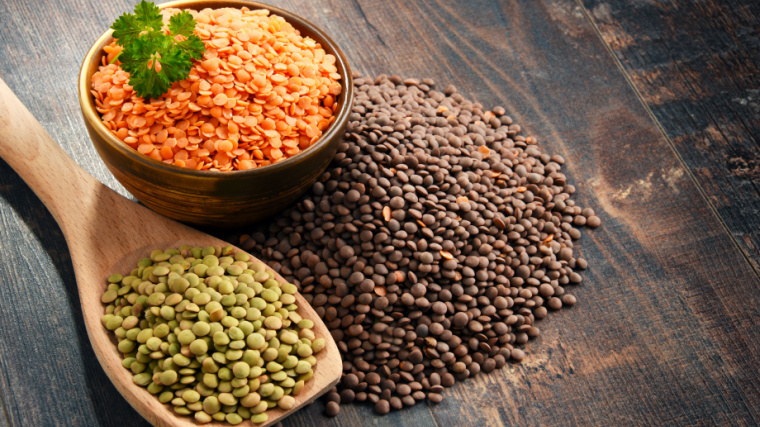
A one-cup serving of lentils typically contains 17.9 grams of protein, 0.8 grams of fat, and 39.9 grams of carbs.
Beans
Beans are a source of healthy carbs but also contain protein and other nutrients. Combining plant-based protein sources makes a well-balanced, healthy meal high in protein.
Black beans are high in protein, fiber, and antioxidants. Chickpeas, also known as garbanzo beans, are rich in protein and fiber. Consuming black beans and chickpeas may help control your blood sugar and reduce your risk of heart disease. (11)
A one-cup serving of black beans yields 15 grams of protein, one gram of fat, and 41 grams of carbs.
One cup of chickpeas (or garbanzo beans) contains 14.5 grams of protein, four grams of fat, and 45 grams of carbs.
Seeds
Topping a yogurt or smoothie bowl with protein-rich seeds is a great way to boost your protein intake with plant protein. Pumpkin seeds and chia seeds are both nutrient-dense options. Pumpkin seeds contain healthy fats and magnesium. Chia seeds are a great source of fiber, antioxidants, and omega-3s.
One 28-gram serving of pumpkin seeds contains 5.27 grams of protein, 5.5 grams of fat, and 15.3 grams of carbs.
One 28-gram serving of chia seeds has 4.68 grams of protein, 8.7 grams of fat, and 11.9 grams of carbohydrates.
Protein Smoothies
When you’re tired of eating chicken or tofu, whipping up a smoothie with high-quality protein powder can help you reach your daily protein intake. Whey protein powder and soy protein powder are both high-quality, complete protein sources. Whey protein contains dairy while soy protein is plant-based. You can also add peanut butter, fresh or frozen fruits, and veggies to bulk up your smoothie.
A one-scoop serving of whey protein contains 25 grams of protein, 0.5 grams of fat, and two grams of carbs.
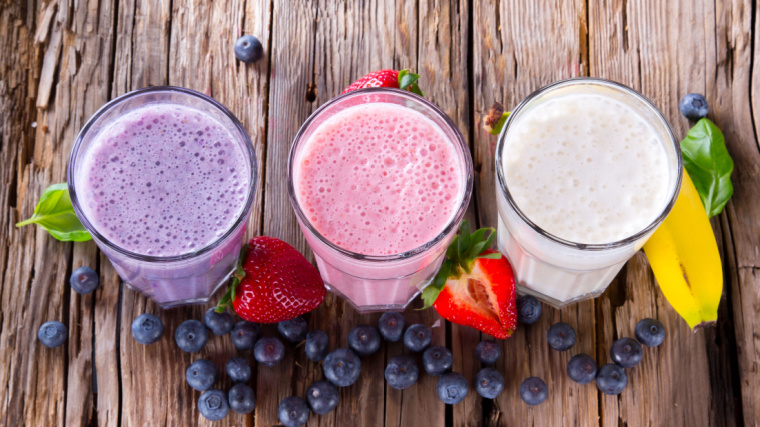
[Read More: What’s the Best Time to Drink Your Pre-Workout Mix?]
One scoop of soy protein has 25 grams of protein, 2.5 grams of fat, and 13 grams of carbs.
The Benefits of Protein
Now that you know the best high-protein foods to choose from, why should you eat them? Getting enough protein can help you build muscle mass, lose body fat, and recover from those intense workouts at the gym. Healthy eating can also improve your heart health.
Helps Build Muscle Mass
When you’re in the gym banging out deadlifts, overhead presses, and back squats, you’re breaking down your muscle fibers. When you eat protein-rich foods, dietary protein gets to work, repairing and regenerating your muscle fibers. Eating enough protein in addition to training leads to muscle protein synthesis and hypertrophy, or muscle growth. (12)(13)
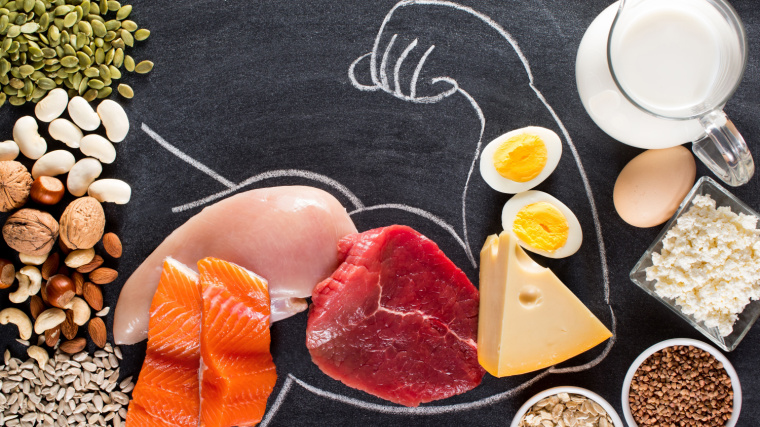
[Read More: The 7 Best Supplement Stacks]
Consuming complete protein sources is important — they contain all the essential amino acids necessary for building skeletal muscle. Choosing any of the whole foods and supplements on our list will get you there.
Helps Muscle Recovery
Recovery is critical to getting the gains you strive for when you lift. Muscle-building is one aspect of muscle recovery.
You also need protein to repair damaged tissues and cells and to stimulate hormonal and metabolic processes. A post-workout protein shake can boost your recovery and immunity. Research suggests that in addition to strength training, protein can improve recovery from endurance and other anaerobic exercises. (14)
[Read More: The Best Ashwagandha Supplements For Sleep, Testosterone, And More]
Some protein powders, like whey, also have antioxidant properties and may help reduce inflammation and soreness. (15)
Protein may also play a role in recovering and healing from an injury. (16)
Helps Fat Loss
It’s not all about building muscle — protein also plays a role in fat loss for athletes. Feeling full from your food can help you stay on track if you’re reducing your calories or portions. Protein is known to increase satiety (feelings of fullness) and may help you on your quest to consume less. (17)
Protein also helps fat loss by increasing thermogenesis. Your body needs to expend more energy to digest protein, slightly increasing your total daily energy expenditure (TDEE). Complete proteins may increase your energy expenditure even more. The protein-rich foods on our list have a high thermic effect, so your body will work harder during digestion. (17)(18)
[Read More: The Best Protein Intake Calculator for Muscle Gain and Fat Loss]
Resistance training is necessary during weight loss to maintain lean muscle mass while losing fat. Research and clinical trials suggest that a high-protein diet helps your body preserve lean muscle or fat-free mass. For people in the trials who lost weight, keeping their protein high helped prevent regaining weight. (17)(19)
Helps Improve Heart Health
Healthy eating and regular exercise are well-known to improve your heart health. Eating enough protein from healthy sources can lower your risk of heart disease and high blood pressure. (20)
A 2020 meta-analysis investigated different types of protein and their association with cardiovascular (CV) diseases. They concluded that plant protein, in particular, may be linked with a reduced risk of CV diseases. (21)
The Mayo Clinic recommends eating lean meats, poultry, fish, low-fat dairy, eggs, and legumes as your protein sources to boost your heart health and help prevent heart disease. (22)
How Much Protein Do You Need?
So, how much protein do you need per day? It depends. The Food and Drug Administration (FDA) states that adults need 50 grams of protein daily as a minimum requirement for bodily functions. (23)
Active people expend more energy and will need more than that. Your personal body needs will vary on your body, activity level, and fitness goals.
Try BarBend’s protein intake calculator to put in your stats and get a customized recommendation.
Protein Intake Calculator
Age
Sex
Height
Weight
Goal
Activity Level
Do you know your body fat percentage?
[Read More: Protein Vs. BCAA Supplements — Which to Take and When? ]
The American College of Sports Medicine (ACSM) recommends that active people get 1.2 to 1.7 grams of protein per kilogram of body weight (or 0.5 to 0.8 grams per pound) daily. (24)
If you’re trying to build muscle or lose body fat, you may still need a bit more, so we’ll take it to another level of specificity.
For Muscle Growth
To build muscle mass, you need to do consistent resistance training and eat enough calories and protein. The ACSM and the International Society of Sports Nutrition (ISSN) give two different recommendations for building muscle mass.
- The ACSM recommends 1.6 grams of protein per kilogram of body weight as the minimum for building muscle. Anything over 2.2 grams may be unnecessary. (24)
- The ISSN suggests 1.4 to 2.0 grams of protein per kilogram of body weight for gaining and maintaining muscle. (25)
Competitive bodybuilders may need a higher protein intake. Evidence shows research shows that most (but not all) bodybuilders can gain muscle by getting 2.3 to 3.1 grams of protein per kilogram of body weight per day. (26)
[Read More: The 12 Best Supplements for Muscle Growth]
Based on these findings, a gymgoer who wants to gain muscle but isn’t competing can aim for 1.4 to 2.2 grams of protein per kilogram of body weight per day to reach their goals.
For Fat Loss
When you want to lose body fat, start by calculating your daily calorie needs, and be sure that you’re resistance training to preserve your lean muscle. Eating a high-protein diet while in a calorie deficit can help your body preserve fat-free mass.
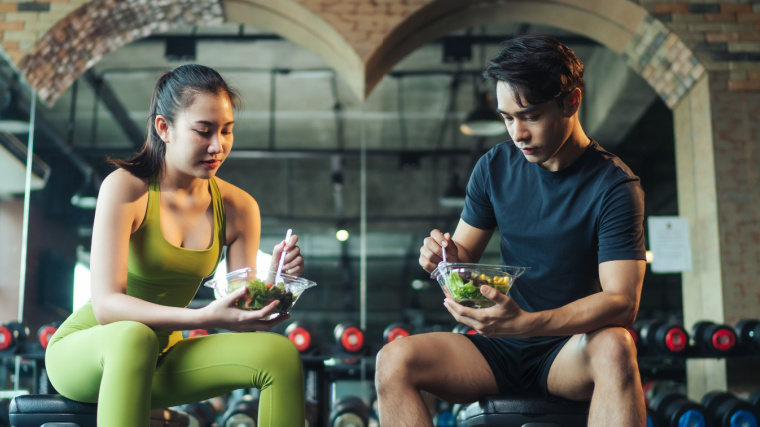
[Read More: The Best Healthy Fast Food Options at the Most Popular U.S. Chains]
The ISSN recommends 2.3 to 3.1 grams of protein per kilogram of body weight per day to lose body fat and maintain lean muscle. (25)
Cook It Up
Eating a high-protein diet can help you gain muscle, stay strong and satiated as you lose body fat, recover from workouts, and boost your cardiovascular health. You don’t need complicated recipes to get your gains. Simply choose from our list of the best high-protein foods for high-quality protein.
The best animal-based protein sources are poultry, lean meats, salmon, dairy products, and eggs. For vegetarians and vegans, choose from tempeh, tofu, quinoa, edamame, lentils, beans, other legumes, and seeds. When you need a supplement for a boost, whey protein powder is the best dairy option, and soy protein powder is great for plant-based protein.
People who eat meat can also benefit from adding more plant protein to their diet. After you break down your muscles at the gym, build them back up with these high-protein foods, and let the gains begin.
FAQs
Here are some common questions and answers on high-protein foods.
It’s helpful to break up this number into how many times you’d like to eat in a day. If you want to have three meals and a snack, aim for 30 grams of protein per meal and add a 10-gram high-protein snack. You could also do four smaller meals with 25 grams of protein each. Play around to find what works best for you.
Eating protein is necessary to recover from training, build muscle, retain muscle while losing body fat, and improve your heart health.
Fruits aren’t particularly high in protein, but guava has the most. A 100-gram serving of guava yields 2.6 grams of protein.
References
- Carreiro AL, Dhillon J, Gordon S, Higgins KA, Jacobs AG, McArthur BM, Redan BW, Rivera RL, Schmidt LR, Mattes RD. The Macronutrients, Appetite, and Energy Intake. Annu Rev Nutr. 2016 Jul 17;36:73-103.
- Camera DM. Evaluating the Effects of Increased Protein Intake on Muscle Strength, Hypertrophy and Power Adaptations with Concurrent Training: A Narrative Review. Sports Med. 2022 Mar;52(3):441-461.
- Watford M, Wu G. Protein. Adv Nutr. 2018 Sep 1;9(5):651-653.
- Lopez MJ, Mohiuddin SS. Biochemistry, Essential Amino Acids. [Updated 2023 Mar 13]. In: StatPearls [Internet]. Treasure Island (FL): StatPearls Publishing; 2023 Jan-.
- USDA. FoodData Central. U.S. Department of Agriculture.
- Shreenath AP, Ameer MA, Dooley J. Selenium Deficiency. [Updated 2022 Jul 19]. In: StatPearls [Internet]. Treasure Island (FL): StatPearls Publishing; 2023 Jan-.
- Kennedy DO. B Vitamins and the Brain: Mechanisms, Dose and Efficacy–A Review. Nutrients. 2016 Jan 27;8(2):68.
- DiNicolantonio JJ, O’Keefe JH. The Benefits of Marine Omega-3s for the Prevention and Treatment of Cardiovascular Disease. Mo Med. 2019 Sep-Oct;116(5):404-408.
- Gammone MA, Riccioni G, Parrinello G, D’Orazio N. Omega-3 Polyunsaturated Fatty Acids: Benefits and Endpoints in Sport. Nutrients. 2018 Dec 27;11(1):46.
- Vega-Gálvez A, Miranda M, Vergara J, Uribe E, Puente L, Martínez EA. Nutrition facts and functional potential of quinoa (Chenopodium quinoa willd.), an ancient Andean grain: a review. J Sci Food Agric. 2010 Dec;90(15):2541-7.
- Winham DM, Hutchins AM, Thompson SV. Glycemic Response to Black Beans and Chickpeas as Part of a Rice Meal: A Randomized Cross-Over Trial. Nutrients. 2017 Oct 4;9(10):1095.
- Camera DM. Evaluating the Effects of Increased Protein Intake on Muscle Strength, Hypertrophy and Power Adaptations with Concurrent Training: A Narrative Review. Sports Med. 2022 Mar;52(3):441-461.
- Stokes T, Hector AJ, Morton RW, McGlory C, Phillips SM. Recent Perspectives Regarding the Role of Dietary Protein for the Promotion of Muscle Hypertrophy with Resistance Exercise Training. Nutrients. 2018 Feb 7;10(2):180.
- Kreider RB, Campbell B. Protein for exercise and recovery. Phys Sportsmed. 2009 Jun;37(2):13-21.
- Marshall K. Therapeutic applications of whey protein. Altern Med Rev. 2004 Jun;9(2):136-56.
- Frankenfield D. Energy expenditure and protein requirements after traumatic injury. Nutr Clin Pract. 2006 Oct;21(5):430-7.
- Paddon-Jones D, Westman E, Mattes RD, Wolfe RR, Astrup A, Westerterp-Plantenga M. Protein, weight management, and satiety. Am J Clin Nutr. 2008 May;87(5):1558S-1561S.
- Westerterp-Plantenga MS, Nieuwenhuizen A, Tomé D, Soenen S, Westerterp KR. Dietary protein, weight loss, and weight maintenance. Annu Rev Nutr. 2009;29:21-41.
- Moon J, Koh G. Clinical Evidence and Mechanisms of High-Protein Diet-Induced Weight Loss. J Obes Metab Syndr. 2020 Sep 30;29(3):166-173.
- Hu FB. Protein, body weight, and cardiovascular health. Am J Clin Nutr. 2005 Jul;82(1 Suppl):242S-247S.
- Qi XX, Shen P. Associations of dietary protein intake with all-cause, cardiovascular disease, and cancer mortality: A systematic review and meta-analysis of cohort studies. Nutr Metab Cardiovasc Dis. 2020 Jun 25;30(7):1094-1105.
- Mayo Clinic Staff (2022, April 28). Heart-healthy diet: 8 steps to prevent heart disease. Mayo Clinic.
- USDA. Current dietary guidelines. Dietary Guidelines for Americans, 2020-2025.
- Rodriguez NR, DiMarco NM, Langley S; American Dietetic Association; Dietitians of Canada; American College of Sports Medicine: Nutrition and Athletic Performance. Position of the American Dietetic Association, Dietitians of Canada, and the American College of Sports Medicine: Nutrition and athletic performance. J Am Diet Assoc. 2009 Mar;109(3):509-27.
- Jäger R, Kerksick CM, Campbell BI, Cribb PJ, Wells SD, Skwiat TM, Purpura M, Ziegenfuss TN, Ferrando AA, Arent SM, Smith-Ryan AE, Stout JR, Arciero PJ, Ormsbee MJ, Taylor LW, Wilborn CD, Kalman DS, Kreider RB, Willoughby DS, Hoffman JR, Krzykowski JL, Antonio J. International Society of Sports Nutrition Position Stand: protein and exercise. J Int Soc Sports Nutr. 2017 Jun 20;14:20.
- Helms ER, Aragon AA, Fitschen PJ. Evidence-based recommendations for natural bodybuilding contest preparation: nutrition and supplementation. J Int Soc Sports Nutr. 2014 May 12;11:20.
Featured Image: beats1 / Shutterstock
The post The Best High-Protein Foods to Help You Pack on Muscle appeared first on BarBend.
